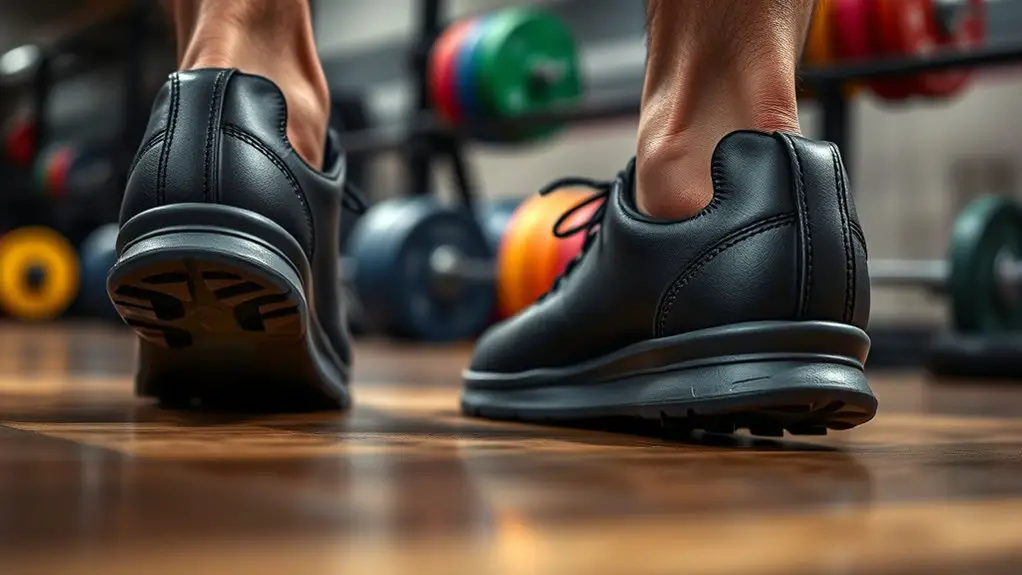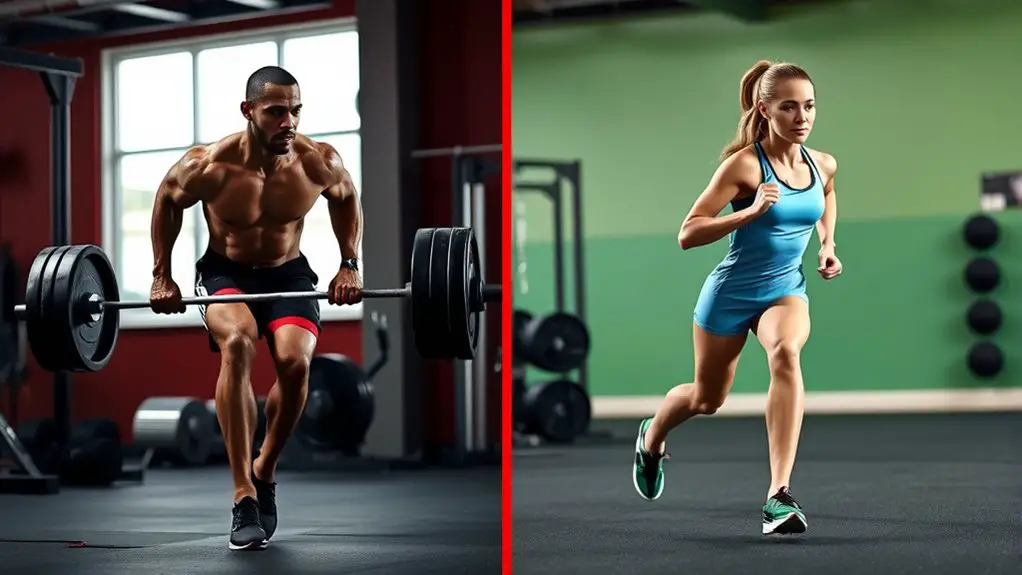Leg strength is essential for your performance in extreme sports. It enhances your ability to execute daring moves and navigate challenging terrains with agility and finesse. Strong legs boost your power, endurance, and stability, helping you prevent injuries and maintain quick, agile movements. Exercises like squats and lunges can amplify your leg strength, leading to better performance metrics. Keep exploring how to integrate effective leg training into your routine for even greater results.
Understanding the Role of Leg Strength in Extreme Sports
Leg strength is the backbone of performance in extreme sports. It's not just about raw power; it's about how well your legs work together. Leg coordination plays an important role in executing those daring moves effortlessly. When you're soaring off a ramp or traversing rocky terrain, having strong legs helps you maintain control and finesse. Plyometric exercises for explosive power, such as box jumps, enhance your ability to perform at your best during extreme sports. Balance training is essential for enhancing that coordination. When you work on your balance, you're teaching your body to react instinctively, whether you're landing a jump or carving through a wave. Strong legs give you the freedom to push your limits while feeling secure in your movements.
Key Muscle Groups Involved in Leg Power
To maximize your leg power for extreme sports, it's essential to understand the key muscle groups involved. The quadriceps and hamstrings provide the strength for explosive movements, while your calves enhance that power. Don't forget the glutes, as they play an important role in stability and overall performance. Incorporating exercises like squats and lunges can significantly improve your leg strength and performance in extreme sports.
Quadriceps and Hamstrings
While you might not think about it often, the quadriceps and hamstrings play a significant role in your overall leg power, especially in extreme sports. Your quadriceps, those powerful muscles at the front of your thighs, provide incredible strength and stability, enabling you to jump higher and land safely. The quadriceps benefits include improved endurance and explosive movements, essential for activities like mountain biking or snowboarding. On the flip side, hamstrings flexibility is important for maintaining balance and preventing injuries. When your hamstrings are flexible, you can achieve more dynamic movements, allowing you to push your limits. So, investing time in strengthening your quadriceps and enhancing your hamstrings' flexibility can release your true potential on the slopes or trails.
Calves for Explosive Power
Although often overlooked, your calves are essential for generating explosive power in extreme sports. These muscles play a vital role in your ability to perform explosive jumps and sprint with agility. When you engage in calf raises, you're not just building strength; you're enhancing your ability to push off the ground with force. This explosive power can make the difference between landing successfully or getting sidelined. Strong calves improve your overall athletic performance, letting you embrace the freedom of movement that extreme sports offer. Don't underestimate the impact of those small muscles; they can propel you to new heights. So, make calf training a priority and feel the difference in your performance. Your adventures await!
Glutes for Stability
When you engage in extreme sports, having strong glutes isn't just a bonus; it's essential for stability and power. Glute activation plays a significant role in maintaining your stability balance, allowing you to navigate challenging terrains with confidence. When your glutes are firing properly, they help stabilize your hips, which directly influences your overall posture and movement efficiency. This stability is critical, whether you're carving through snow on a snowboard or landing a jump on a skateboard. By focusing on strengthening your glutes, you're not just enhancing your performance; you're also reducing the risk of injury. So, embrace exercises that target these powerful muscles, and give yourself the freedom to push boundaries in your extreme sports adventures.
The Impact of Leg Strength on Performance Metrics
Leg strength plays an essential role in your overall performance metrics, impacting how much power you can generate in your sport. It also enhances your endurance and stamina, allowing you to push through longer sessions without fatigue. Plus, strong legs are key to injury prevention, helping you stay in the game longer and perform at your best. Incorporating exercises like squats and deadlifts into your training can significantly boost your leg strength and overall athletic performance.
Power Generation in Sports
While many factors contribute to an athlete's overall performance, leg strength plays an essential role in power generation across various extreme sports. Your legs are the foundation for explosive movement, allowing you to release power dynamics that propel you to new heights—literally and figuratively. Strong legs enable you to generate force quickly, whether you're jumping off a cliff, sprinting on a trail, or carving through snow. This explosive power translates into better performance metrics, giving you that exhilarating edge in competition. When you're equipped with solid leg strength, you won't just participate; you'll dominate. Embracing the freedom to push your limits is crucial, and it starts with strengthening those essential muscles that drive your athletic journey.
Endurance and Stamina Benefits
Although many athletes focus on explosive power, endurance and stamina are equally essential for maintaining peak performance in extreme sports. Building leg strength through targeted endurance training can greatly enhance your stamina improvement, allowing you to push your limits longer without fatigue. Strong legs support sustained activity, whether you're scaling a rock face or powering through a long-distance run. This strength enables you to generate consistent force, helping you tackle challenging terrains with ease. By dedicating time to endurance training, you'll not only boost your physical capabilities but also cultivate a sense of freedom in your movements. Embrace the journey of developing your leg strength, and you'll discover how it transforms your performance, letting you soar in your extreme sports adventures.
Injury Prevention Strategies
Strong legs not only enhance your performance in extreme sports but also play an essential role in injury prevention. By focusing on leg strength, you can minimize the risk of injuries that come from high-impact activities. Incorporating crucial practices like stretching techniques and effective recovery methods can further protect you.
| Strategy | Benefits | Implementation |
|---|---|---|
| Leg Strength Training | Increases stability | Squats, deadlifts |
| Stretching Techniques | Improves flexibility | Dynamic stretches |
| Recovery Methods | Reduces muscle soreness | Foam rolling, rest |
Injury Prevention Through Strong Legs
When athletes engage in extreme sports, having strong legs isn't just about performance; it's vital for injury prevention. Your legs support your entire body, and if they're weak, you're more prone to injuries like sprains and strains. Strong legs help maintain balance and stability, reducing the risk of falls or missteps that could lead to serious harm. By addressing muscle imbalances through targeted strength training, you can guarantee that all muscle groups are working harmoniously, which is important for endurance and agility. Incorporating rehabilitation techniques into your routine can also enhance recovery and keep injuries at bay. Additionally, proper warm-up techniques can significantly reduce the risk of hamstring injuries by preparing your muscles for the demands of extreme sports. This way, you can push your limits and enjoy the freedom of extreme sports without the constant worry of getting hurt. So, invest in your leg strength; it's your best defense against injury, allowing you to fully embrace your adventurous spirit.
Effective Leg Strength Training Exercises
Building on the importance of strong legs for preventing injuries, incorporating effective leg strength training exercises is vital to enhancing your performance in extreme sports. You'll want to focus on a mix of resistance training and plyometric drills to build power and endurance.
Start with squats and lunges, which are fantastic for building overall leg strength. Add resistance bands or weights to challenge yourself further. Then, integrate plyometric drills like box jumps and jump squats to develop explosive power, essential for quick movements in extreme sports. Plyometric training can significantly improve neuromuscular control, which is crucial for executing complex movements effectively.
Don't forget about balance exercises, such as single-leg deadlifts, which enhance stability and coordination. Aim for a balanced routine that targets all major muscle groups in your legs. By committing to these exercises, you'll not only boost your leg strength but also unleash your full potential in the exhilarating world of extreme sports.
Integrating Leg Training Into Your Extreme Sports Routine
To maximize your performance in extreme sports, it's vital to seamlessly integrate leg training into your overall routine. You don't want to feel limited; strong legs give you the freedom to push boundaries. Start by incorporating leg workouts that target strength, endurance, and flexibility. Squats, lunges, and plyometric exercises are excellent choices.
Aim for a training frequency that fits your lifestyle—consider two to three sessions a week. This consistency will build the leg strength you need for high-impact activities, like mountain biking or rock climbing. Muscular endurance is crucial for sustaining the physical demands of these sports, so be sure to incorporate exercises that improve this aspect as well. Listen to your body; recovery is just as important as the workouts themselves.
Mix in dynamic stretches before your training and cool down with static stretches afterward to enhance mobility. By weaving leg training into your routine, you'll cultivate resilience and power, enabling you to conquer your favorite extreme sports with confidence. Keep it engaging, and enjoy the journey!
Frequently Asked Questions
Can Leg Strength Improve My Overall Athletic Performance in Other Sports?
Absolutely, leg strength can boost your overall athletic performance in other sports. By incorporating sport-specific exercises into your routine, you'll enhance your power, stability, and endurance. Plus, cross training benefits your entire body, helping you gain a competitive edge. Strong legs support agility and speed, essential for any sport. So, if you want that freedom to excel in various activities, focusing on leg strength is a smart move you won't regret!
How Does Body Weight Affect Leg Strength Training Outcomes?
You might think body weight doesn't matter in leg strength training, but it actually plays an essential role. Your body composition and weight distribution directly impact how effectively you can build strength. Lighter individuals often find it easier to move, allowing for more dynamic exercises, while those with heavier body weight may face different challenges. Ultimately, understanding how your body weight affects your training can help you access your potential and embrace true freedom in movement.
What Are Common Mistakes in Leg Strength Training for Extreme Sports?
When it comes to leg strength training, common mistakes can really hold you back. You might not be varying your exercises enough, leading to plateaus and boredom. Plus, be cautious of overtraining risks; pushing too hard without adequate recovery can cause injuries and fatigue. Remember, your body thrives on variety and balanced intensity, so mix it up to keep progressing and enjoying your training. Embrace the journey and let your legs gain strength naturally!
How Long Does It Take to See Results From Leg Strength Training?
You might think results from leg strength training come quickly, but the truth is it varies. With consistent training frequency and proper muscle recovery, you could start seeing changes in 4 to 6 weeks. Remember, everyone's body responds differently, so don't rush the process. Focus on enjoying your journey, strengthening those legs, and embracing the freedom that comes with improved performance. Patience and persistence will lead to the results you crave.
Should I Prioritize Leg Strength Over Other Muscle Groups for Extreme Sports?
You should definitely prioritize leg strength, but don't neglect other muscle groups. Strong legs provide the foundation for explosive movement and stability, essential for any extreme sport. However, muscle balance is key; if you focus solely on legs, you might risk injury or performance issues. So, while leg strength is important, maintaining overall body strength will give you the freedom and power you need to excel in your chosen extreme activities.




